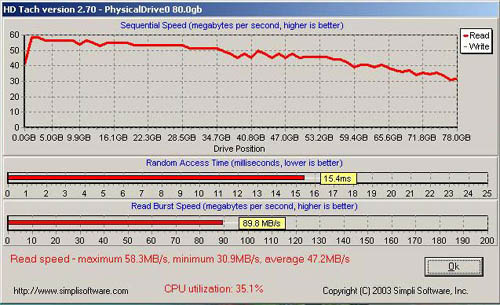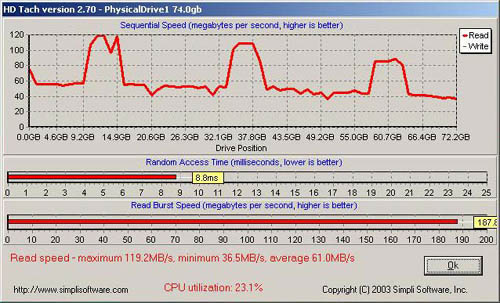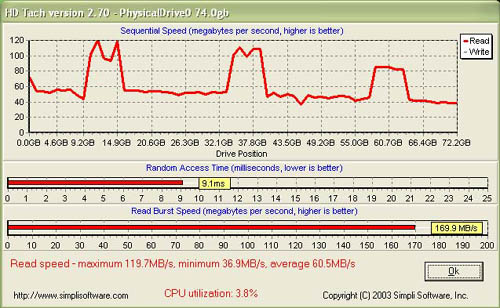nForce3-250 - Part 2: Taking Athlon 64 to the Next Level
by Wesley Fink on March 29, 2004 11:00 AM EST- Posted in
- CPUs
nForce3-250Gb: IDE and RAID Benchmarks
Disk Performance Testing can provide extremely variable results, even when test conditions are well-controlled. For that reason, we were skeptical to drop IDE and RAID tests into our review of the nForce3-250Gb. However, it was certain, given nVidia's past lackluster drive performance, that HD tests should be included in nF3-250 benchmarking.Some of the most commonly used benchmarks for Hard Drive Testing are HDtach 2.7, PCMark 2004 HD Tests and SiSoft Sandra 2004 File System Benchmark. We have included all 3 test results here for both IDE and nVidia RAID. Tests in both cases were run on Hard Drives about 20% full, with the benchmark run from the IDE hard drive. The IDE hard drive was a 7200 RPM 80GB drive with a 50GB C: boot partition, and tests were run on C:. The RAID array was 2 Western Digital Raptor 10,000 RPM 36.7GB hard drives. Both the IDE and RAID were driven by nVidia IDE drivers in nForce Platform Driver 4.04.
Sandra 2004 shows a 38% increase in throughput with nVidia 10,000RPM RAID compared to a single 10,000RPM SATA drive. PCMark 2004 HDD Test Suite shows a smaller increase in performance with RAID, around 27%. Benchmarks for a single 7200RPM IDE are also included for comparison.
Perhaps even more important for critics of past nVidia IDE implementations is that nVidia and Intel throughput in IDE is now about the same with the nForce3-250Gb. Intel SATA RAID is a bit faster in Sandra, but the difference in measured benchmark performance was very small, at about 6%.
For those who hate the numbers from benchmarks like Sandra and PCMark, the HDTach screen captures provide a very interesting snapshot. The two graphs below, with blue title bars, represent nVidia's nForce3-250Gb drive controller performance.


We also tested the Intel RAID controller with another pair of 10,000 rpm Western Digital Raptors. Those results are shown with the green title bar below.

As you can see, performance of the Intel SATA RAID and nVidia SATA RAID are virtually identical.
The biggest surprise in the HD Tach benchmarks was the fact that SATA RAID requires half the overhead of basic IDE in nVidia's implementation. However, the CPU utilization, while greatly improved over numbers we have seen for nVidia in the past, is still very high compared to Intel's SATA RAID. Part of this has to do with the architectural differences between Athlon 64 and Intel processors and chipsets, but there is still a large difference in CPU overhead between the nVidia and Intel RAID solutions. Frankly, the real performance difference is likely to be nil on the typical desktop, but this will matter to some.










46 Comments
View All Comments
PrinceGaz - Friday, April 2, 2004 - link
I was also staggered by how bothered some people were with SoundStorm -- it was never state-of-the art sound, just like how the onboard GeForce4 MX-like graphics the nForce2 had was something no serious gamer would be happy with. If you want top good quality sound you buy something specifically designed for it as you'll never get it on a motherboard (unless you live in an AOpen fantasy world and think putting valves on a motherboard counts).The CPU utilisation while using RAID on the nVidia chipset, and also on a straight IDE drive as well, did come as a bit of a surprise to me. I'm into capturing and encoding high-quality video so excessive CPU load from disk-access while doing so would be a real issue to me as it demands both CPU power as well as disk-throughput.
vlor - Friday, April 2, 2004 - link
hummm,I only saw a few things that bugged me but what amazes me is out of all the people who posted, hafc why sound storm wasn't on the 250... do a little research and you will find that the codec's cause interference, and we as take up significantly more signal processing than most people care to think about. I'd love to see what Nvidia could do with a riser card once the PCI buss isn't so saturated. Oh and the is a board with an realtek850 linked to an nforce2, and DFI doesn't even mention sound storm but the setup is one of the better soundstorms out there including my asus deluxe.
Reflex - Wednesday, March 31, 2004 - link
Wow, the hate level here is extreme, especially since it was a pretty good review overall...Phiro: Go elsewhere. Your not being helpful at all, and your complaints are simply rediculous in many situations. If you really want the level of technical detail you seem to be demanding(but do not appear to have the background to comprehend), go to Ace's Hardware. More knowledge than you'll ever need to know.
As for the nit-pickers: A bit of terminology was off, however overall they were accurate and I think some of these complaints are not concerning any mistake Anandtech made, but simply that they did not include information that you personally felt should be in there(never mind the fact that since you noticed it missing, it apparantly is information you already knew). I also will point out that much of what you are complaining about is already covered in previous articles on the various technologies, and are available for anyone who wants to know exactly what HyperTransport means, etc. Nothing wrong with clicking a few links to find it. I would not mind seeing AT add a 'related articles' link somewhere obvious with all related technologies listed(and possibly even some off site links, Ace's and Ars Technica often have great technology writeups). But its not that big a deal overall...
To the guys about SoundStorm: You are really in the minority, anyone interested in quality sound uses and add-on card already, and as for basic sound the solution they are including is good enough for them. Your essentially begging for a mid-range to low end solution on an already feature rich setup, I'd say spend the $40 on something like that if you really want to, or just drop $20 more and you can have a Santa Cruz and blow it out of the water.... It is not a huge loss, its the first thing I disabled on my NF2 board.
Anandtech: Keep up the good work. I can't wait to see the first PCI Express capable chipset review..
Da3dalus - Tuesday, March 30, 2004 - link
There should be tests of the 5950U on a non-nVidia chipset as well, to see how much it gains when coupled with the nf3-250Gb. It just seems a bit lacking in that right now.agent2099 - Tuesday, March 30, 2004 - link
“Apparently you COMPLETLY overlooked the fact that most (all, AFAIK) SoundStorm boards offered digital output which bypassed those codec's completly. Which just happens to be EXACTLY what I use, and was a major selling point, allowing me to send out my DD/DTS signal to my amp for DVD's as I use for regular computer use. VERY handy”I agree, I think the lack of soundstorm is a huge oversight. I currently use the digital (optical out) from my nforce2 board and couldn’t live without it. This is especially important for SFF PCs.
“I do not find it surprising at all that most customers don't care about the sound storm stuff. After all, the vast majority of PC users (outside of the geek market of course) have their PC hooked up to $9.99 basic speakers -- sound storm is not going to make a difference at all, and is simply not a selling point.”
Well of course we are talking about the “geek market.” If we are talking about the average PC user that has $9.99 speakers, they don’t need ½ of the other things on the chipset, including SATA RAID and Gigabit Ethernet.
Foxbat121 - Tuesday, March 30, 2004 - link
I'm a little disappointed and alarmed by the high CPU utilization (up to 35.1%) on this nVidia chipset(or maybe all A64 platform?) compared to Intel's 3.8% CPU utilization. Which means your CPU could spend 1/3 of its time processing disk access during disk intensive operations.Nighteye2 - Tuesday, March 30, 2004 - link
the single 10k benchmark is a good addition, but there still isn't any comparison of SATA RAID between 2 Athlon 64 systems - can you add the SATA RAID performance of the integrated RAID of the ASUS K8V MB? The review just isn't complete without a good comparison of RAID performance to a similar platform. (with the same processor)Wesley Fink - Tuesday, March 30, 2004 - link
#38 -This is not completely accurate. While there is not and will not be a specific dual-channel version of the chipset, as you point out, Ultra is not the same chipset. Ultra for nVidia represents the 1000 HyperTransport bus, while the regular designation of nForce3-250Gb represents 800 HyperTransport. The chipset in the nVidia Reference Board we tested, as we clearly spelled out in the review, is the nForce3-250Gb Ultra used in a socket 754 configuration. Since it is used in Socket 754 it is a single-channel memory configuration, but it does offer 1000 HyperTransport.
It is true than any of the nVidia chipsets can be used in any of the Athlon 64 Socket configurations, but the available HT and features do vary, whether by design or binning. An nForce3-150 on Socket 940 boards was still 600HT.
As you point out, the names will likely be used in confusing ways, and features can be limited by the board manufacturer's design, but nForce3-250 Ultra is 1000HT, nForce3-250 is 800HT, and nForce3-150 is 600HT. The Gb represents the versions with on-chip Gigabit LAN and Firewall.
There are early 800HT versions of the 250 chip floating around, but like Intel's 875/865 the HT frequency will likely result from binning - those that fail 1000HT become 800HT versions.
Cygni - Tuesday, March 30, 2004 - link
"", on the dual-channel nForce3-250Gb Ultra version of this chipset."I want to emphasis that THERE IS NO and WILL BE NO "dual channel CHIPSET version" for A64, S754, S939, S940 or whatever. If Nvidia wants to make us to believe "buy newer and more costly nf3-250 ULTRA boards for S939" this does not mean that we (and mobo makers) should believe them and not use S939 CPUs with non-Ultra nf3s."
If you are using a Nforce3-250 chipset on a S939 board, it automatically becomes an "Ultra". Its not a different chip. AMD has announced that the A64's for Socket 939 will be dual channel, making the Nforce3-250 Ultra the member of this family that will see dual channel. In that sense, the NF3-250-U is tbe dual channel version.
wassup4u2 - Monday, March 29, 2004 - link
To clear up a little A64 confusion... Hyper Transport vs. Front Side Bus. The A64, as we all know, has an integrated memory controller. The FSB always has been, and always will be, the link between the processor and the memory. In the K8, I believe, all frequencies are determined based on multipliers of the HTT frequency. Unlike in P4/AXP systems, in which the memory controller is on a separate chip and all frequencies are multipliers of the FSB. So by increasing the FSB, you can increase memory performance. In a 2U or more config, HTT is the bus connecting the CPUs and the chipset. That's why there's not much of a performance difference between NF3-150 (600MHz HTT) and K8T800 (800MHz HTT).And enough with all the hating! This article did have its flaws, but by the way ppl are talking, you'd think it was in Chinese originally and translated by an online translator.